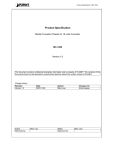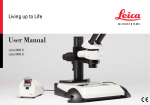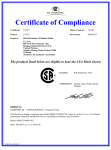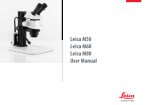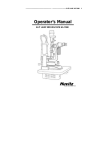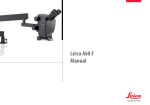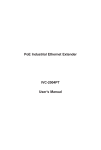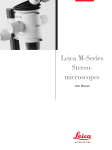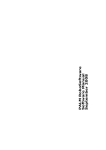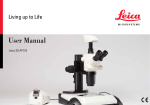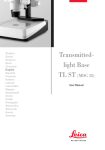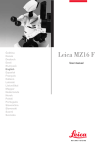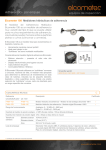Download TRD 06: Stereomicroscope User Manual
Transcript
THE REGIONAL TRAINING WORKSHOP ON LARVAL FISH IDENTIFICATION AND FISH EARLY LIFE HISTORY SCIENCE SEAFDEC/TD, SAMUT PRAKAN, THAILAND 16 – 31 MAY 2007 TRD 06: Stereomicroscope User Manual SAFETY INSTRUCTIONS FOR USING THE COMPOUND MICROSCOPE In order to fully utilize your microscope safely, please notice the following important instructions before starting with the microscope. A. Before turning on the power Plug the electrical connection of the stand or light source to the electrical supply. Before plugging and turning on the power, make sure that the operation voltage of the microscope does match with the voltage supply. B. Changing the bulb 1. Before changing the bulb, make sure that the power switch is off and the power cord has been disconnected from the main supply. 2. Carefully remove the old light bulb from the socket and plug the new bulb in. 3. Never touch the glass surface of the bulb with naked hand. Any grease stain brought onto the bulb by the naked hand will negatively affect the heat dissipation and, thus, greatly shorten the life span of the bulb. Clean the bulb surface with alcohol and tissue if the user has touched the bulb surface accidentally. 4. Specifications of light bulb can be found on the surface of the microscope. If required, please contact your local agent for supply of new light bulbs. C. Care and cleaning of the microscope To take good care of the microscope, the user should avoid the attack of dust and water. If dust and water come to the microscope, fungus will eventually grow and kill the microscope. Please notice that once fungus is grown, even after cleaning, the microscope will have a good chance to be re-infected again. Moreover, grease stain and fingerprints will distort the image, which should be avoided. 1. Protection against dust When the instrument is not used for a long period of time, cover it with the enclosed dust cover. Never leave the eyepiece tube open without any covers. Either leave the eyepiece in the tube (recommended if the microscope is used very frequently) or cover it with wrapping paper or covering cap. Eyepieces and other optical accessories, when not in use, are recommended to be kept in a dry box to protect them against dust and water. 2. Protection against water The instrument should be kept away from water source, pipeline or water sink. Humidity in the room where the instrument is located should be as low as possible (relative humidity should be kept below 70 %). All the optical accessories are recommended to be kept in a dry box when not in use. The use of dehumidifier and 24-hour air conditioning is highly recommended if the surrounding is very humid. 3. Cleaning a. P.1 If dust is found on the optical surface, try to remove it by air blower or compressed air. P.2 b. • • For fingerprints, grease stain or dust which cannot be removed by air blower, two possible methods are recommended:- The microscope should always be kept vertical when being moved. 5. Electrical parts of the microscope Breathe lightly on the glass surface and wipe with a piece of clean cloth, lens paper or cotton swab. Please notice that small cotton fibre may be left onto the lens surface if a cotton swab is used. Dip a cotton swab or lens paper with a small amount of absolute alcohol, and clean the lens surface carefully. No other aggressive solvents should be used. In no circumstances should the user clean any lens surface with dry cotton swab, cloth or lens paper. This will scratch the lens surface causing irreparable damage. Water is not recommended for cleaning of lens as it will leave some water stain on the lens surface and if water residue is left on the lens, fungus can grow causing irreparable damage. 4. Moving the microscope a. The microscope should not be moved around whenever it is possible. b. If moving is unavoidable, the user should ensure that, before moving, the eyepieces are firmly locked in the eyepiece tube and all objectives are tightly screwed onto the nosepiece. c. d. The user should move the microscope with both hands, one hand holding the bottom of the stand and the other hand holding the upper limb of the microscope. When moving the microscope, it is always best to have the eyepiece tube facing" away from the user. P.3 a. Before plugging in the power cord with the supply, make sure that the supplying voltage matches with the operation voltage of the equipment. b. Turn off the equipment before plugging in the power card with the supply. c. The best practice is to turn the voltage clown to the lowest before turning off the equipment. d. Do not turn the power on and off, off and on immediately as this will shorten the life span of the bulbs and may cause damage to the electrical system. e. Users should observe all local safety regulations of the region. The equipment is manufactured according to CE, UL and other Safety Instruction. However, users do have full responsibility to use this equipment safely. * * SHOULD YOU HAVE ANY PROBLEMS CONCERNING USING THE MICROSCOPE, PLEASE CONTACT YOUR AGENT IMMEDIATELY. WE ARE ALWAYS READY TO HELP IN ALL ASPECTS. * * * * BECAUSE OF TECHNOLOGICAL ADVANCEMENT, THESE SAFETY INSTRUCTIONS ARE SUBJECT TO CHANGE WITHOUT PRIOR NOTICE AND WITHOUT OBLIGATION. * * YOUR LOCAL AGENT:- P.4 Microscopy from Carl Zeiss SteREO Discovery.V8 A New View of Things Brilliant Entry into the Class of Sophisticated Stereomicroscopes SteREO Discovery.V8: Enhanced Viewing New high-performance optics – this is the outstanding performance feature that Carl Zeiss has focused on with the development of its latest entry level model in the sophisticated stereomicroscope class. The SteREO Discovery.V8 impresses with enhanced resolution, increased contrast and, most notably, a perceptibly improved stereoscopic impression. As a result, it offers a image brilliance that is without equal in this class of instrument. For a visible increase in information in all biomedical and industrial applications, the time has come for a new view of things. SteREO Discovery.V8 at a glance: • Supreme ease of operation and ergonomic viewing posture • Zoom range of 8 : 1 • Optimized optics design for a visible increase in image information • Manual focusing drive with adjustable click stops • Manual and motorized stands with high stability • Generous specimen space with high working distance • Illumination and contrast methods based on cold light and LED PCB Laterally grazing reflected light Objective: Plan S 1.0x Magnification: 16x* 2 Mouth parts of the common housefly Oblique illumination in brightfield transmitted light Objective: PlanApo S 1.0x Magnification: 80x* * Magnification when looking into the SteREO Discovery.V8 Wafer structure Darkfield reflected light Objective: PlanApo S 1.5x Magnification: 120x* SteREO Discovery.V8 The Optical System: More Than the Sum of its Individual Components Today, anyone developing a stereomicroscope that stereoscopic impression of the microscopic image. sets new standards with its optical system has to work Even on our SteREO Discovery.V8 entry level model. constructively at the very limits of physical feasibility, taking full advantage of every new possibility offered Another area we focused on during practical realiza- by state-of-the-art optical design. With experience and tion was the systematic minimization of stray light for innovativeness, you don’t have to look any further the entire optical system. For exceptionally brilliant than the optical systems from Carl Zeiss. contrast and a new image quality with greater information content. The innovative simultaneous design process during optical modeling has resulted in a standardized optical concept for all SteREO microscopes. For significantly improved resolution and a perceptibly better 3 ranges of high-quality objectives Achromat S: high-contrast images with a pronounced stereoscopic impression Plan S: flat, distortion-free object fields PlanApo S: precisely detailed resolution with no color fringes 4 Parfocally harmonized for needle-sharp images over the entire magnification range from 1x to 8x: the new zoom body of SteREO Discovery.V8 Contrasts with variable optimization in brightfield, darkfield and oblique light: the transmitted light equipment S The Illumination: Show Your Specimen in a New Cold Light The quality of the illumination – this is all-important source outperforms conventional fiber-optic systems for contrasting in stereomicroscopy. The new fiber- thanks to several practical advantages, and offers optic CL 1500 ECO cold light source with its wide excellent performance at a superb price! range of light guides and accessories offers you a variety of opportunities for highlighting your struc- Incidentally, lamps and filters can be changed quick- tures perfectly. ly and conveniently. Even when stacked. Designed for slimline, space-saving light guides, opti- a. mized for flicker-free live images on the monitor, providing constant light output even if the line voltage fluctuates, and with ventilation as quiet as a whisper – the high-intensity CL 1500 ECO cold light The fiber-optic CL 1500 ECO cold light source illuminates the specimen precisely with intensive infrared-free light. Here with a twin-arm goose neck for oblique reflected light with a targeted shadow effect. b. c. SMD-Board with white solder resist Reflected light with different light guides a. Linear slit light for lateral grazing light b. Fiber-optic annular slit illuminator for shadow-free 360° reflected light c. Annular slit illuminator with polarization filter device to minimize reflective glare Objective: Plan S 1.0x Magnification: 15x 5 Quiet, durable and offering the best in daylight quality: VisiLED LED illumination Or in a Completely Different Light: With White LEDs Providing the ability to change rapidly from shadow- to 4 illumination settings can be stored and repro- free annular illumination to lateral oblique light, con- duced again at any time. trast optimization through turning of oblique light around the specimen, continuous rotation of the illumi- The MC1500 multicontroller of the VisiLED system nation for a stereoscopic impression of the object in the allows control of reflected, transmitted and blended live image – and all this at the push of a button! The list light. of new contrasting possibilities offered by the VisiLED illumination system with its white LEDs is endless! a. Each of the annular VisiLED illuminators is made up of eight LED segments that can be switched variably. A further advantage of noise-free light sources: up The VisiLED HCT contrast stage offers a wide range of contrasts. It contains separate LED illuminators for brightfield and darkfield, and sliders for finely adjustable oblique light. The LEDs are controlled using the MC1500 multicontroller. b. c. Mouth parts of the common housefly Transmitted light with VisiLED HCT contrast stage a. Brightfield b. Lateral darkfield c. Oblique brightfield illumination Objective: PlanApo S 1.0x Magnification: 80x 6 The Expandable Platform: Flexible For a Variety of Applications A typical feature of stereomicroscopes is their mod- 1. ular system design. Equipped with intelligent interfaces and fully integrated into the Carl Zeiss systems, SteREO Discovery.V8, with its comprehensive range of accessories, offers you a great deal of freedom in terms of organizing your workplace to suit your own practical needs. 1. Interface with digital image worlds: documentation SteREO Discovery.V8 creates a connection for a variety of digital photo and video cameras, via various phototubes, with interface 60N. For the simple documentation of stereomicroscopic images, consumer cameras, with their good price/performance ratio, are often recommended. Anyone wishing to satisfy higher demands should use the high-resolution AxioCam microscope cameras and the AxioVision imaging software from Carl Zeiss. 2. Brilliant fluorescence: PentaFluar S PentaFluar S is the name of the retrofittable fluorescence equipment for stereomicroscopes belonging to the SteREO Discovery family. With up to five different filter blocks in the magazine and special high-performance light sources, this is an outstanding addition for contemporary fluorescence applications in stereomicroscopy. 2. 3. 3. Better in position: the binocular ergo-phototube S 5-45° Ergonomics is also about choosing a relaxed sitting position when operating a microscope. The viewing angle and height have to coincide. The ergotube allows a free choice of viewing angle between 5 and 45 degrees. Intermediate tubes and two working positions for the eyepiece clamps vary the viewing height. 4. Vertical 2D impression: the objective slide A must for documentation with subsequent image analysis, e.g. digital object measurements: the S/doc objective slide for the SteREO Discovery family of microscopes. Positioned directly beneath the zoom body, it enables the objective to be shifted precisely under one of the stereoscopic beam path for a vertical view of your specimen. 7 4. 8 System Overview 9 SteREO Discovery.V8: The Technical Data Objectives Eyepieces Description Factor FWD (mm) WPL 10x/23 Br. foc PL 16x/16 Br. foc W 25x/10 foc Magnification Object Field (mm) Magnification Object Field (mm) Magnification Object Field (mm) PlanApo S 0,63x 81 6,3x … 50,4x 36,5 … 4,6 10,1x … 80,6x 25,4 … 3,2 15,8x … 126x 15,9 … 2,0 PlanApo S 1,0x 60 10x … 80x 23,0 … 2,9 16x … 128x 16,0 … 2,0 25x … 200x PlanApo S 1,5x 30 15x … 120x 15,3 … 1,9 24x … 192x 10,7 … 1,3 37,5x … 300x 6,7 … 0,8 Plan S 1,0x 81 10x … 80x 23,0 … 2,9 16x … 128x 16,0 … 2,0 25x … 200x 10,0 … 1,3 Achromat S 0,3x 253 3x … 24x 76,7 … 9,6 4,8x … 38,4x 53,3 … 6,7 7,5x … 60x 33,3 … 4,2 Achromat S 0,5x 151 5x … 40x 46,0 … 5,8 8x … 64x 32,0 … 4,0 12,5x … 100x 20,0 … 2,5 Achromat S 0,63x 115 6,3x … 50,4x 36,5 … 4,6 10,1x … 80,6x 25,4 … 3,2 15,8x … 126x 15,9 … 2,0 Achromat S 1,0x 69 10x … 80x 23,0 … 2,9 16x … 128x 16,0 … 2,0 25x … 200x Achromat S 1,5x 28 15x … 120x 15,3 … 1,9 24x … 192x 10,7 … 1,3 37,5x … 300x 6,7 … 0,8 10,0 … 1,3 P.O.B. 4041, 37030 Göttingen, Germany Phone: +49 551 5060 660 Fax: +49 551 5060 464 E-mail: [email protected] www.zeiss.de/stereo-discovery Subject to change. Carl Zeiss MicroImaging GmbH Printed on environmentally-friendly paper, bleached without the use of chlorine. 10,0 … 1,3 46-0087 e 03.2006




































